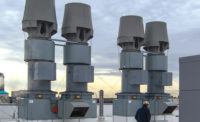Lightning strikes are an awe-inspiring yet dangerous natural phenomenon. Because the damage and fires happen one event at a time, they don’t get the media attention that hurricanes, floods or tornadoes get. But, thunderstorms are, by far, the severe weather phenomenon we all encounter most frequently.
For property owners and managers, it's essential to understand the tools available to mitigate the risks associated with lightning. Two commonly cited solutions are lightning protection systems and surge suppression. While they both address issues related to lightning, they serve distinctly different purposes. This article delves into the differences between the two and the importance of including both to provide effective protection for your property.
Lightning Protection System
What is it? A lightning protection system is designed to prevent lightning from causing direct physical damage by providing a means for the lightning strike to follow, ensuring it's directed safely into the ground.
Key Components
· Air Terminals (Lightning Rods): Metal rods installed at intervals across the structure's highest points.
· Conductors: Metal paths that interconnect the air terminals and provide a route for the lightning discharge to safely follow.
· Bonding: Interconnections between the lightning protection conductors and metallic systems on a structure, such as plumbing or railings.
· Grounding Electrodes: These direct the lightning charge safely into the earth, preventing it from causing damage to the structure or its occupants.
Primary Purpose: To protect physical structures (e.g., buildings, trees, or monuments) from being damaged by direct lightning strikes. Absent a lightning protection system, a direct lightning strike can start fires, burn electronics, explode bricks or masonry and cause other structural damage.
Surge Suppression
What is it? Surge suppressors, also known as surge protection devices or transient voltage surge suppressors (TVSS), are designed to protect electrical devices from voltage spikes caused either by lightning or other electrical disturbances.
Key Components
· Transient Voltage Detector: This component detects sudden over-voltages.
· Surge Protection Circuitry: This part of the suppressor reacts quickly to divert or neutralize the unwanted voltage away from the connected devices.
· Indicator: Many surge suppressors come with an indicator (often an LED light) to show if it's functioning correctly.
Primary Purpose: To protect electrical and electronic equipment from damage caused by sudden voltage spikes, ensuring longevity and preventing data loss. These spikes are typically caused by anomalies in the power supply or nearby lightning strikes.
The Synergy between Lightning Protection Systems and Surge Suppression
While lightning protection systems and surge suppression serve different functions, they are complementary. Think of a lightning protection system as the first line of defense, preventing the lightning strike's direct impact on a structure. Meanwhile, surge suppression is the second line of defense, protecting the sensitive electronic equipment inside that structure from the indirect effects of the strike, such as electrical surges that can travel along power lines or other conduits.
Not-So-Common Fact: Even if a lightning strike hits several miles away from your location, it can still cause electrical surges strong enough to damage sensitive electronics. This fact underscores the importance of having both a robust lightning protection system and effective surge suppressors in place.
Conclusion
Understanding the differences between lightning protection systems and surge suppression is vital for comprehensive protection against lightning's myriad threats. By integrating both into your protection strategy, you ensure not only the safety of your structure but also the invaluable electronic equipment housed within. Stay safe and always prioritize preventive measures against unpredictable natural events like lightning strikes.



